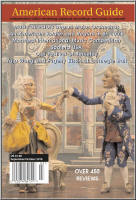Texte paru dans: / Appeared in: |
|
|
Outil de traduction ~ (Très approximatif) |
|
|
Reviewer: John
W. Barker
It is not a strictly narrative work. It is cast in the episodic form of nine betrachtungen or contemplations, successively on the Last Supper, Christ’s prediction of Peter’s betrayal, Jesus in the Garden of Gethsemane, the trial and humiliation of Jesus, the denial by Peter, the suffering of the abused Jesus, the Crucifixion, the death of Jesus, and the burial in the tomb. The text was apparently written by Telemann himself, who was steeped in Lutheran pietism. Amid the contemplations three Scriptural characters do appear: Peter (Feyfar), Caiphas (Neven), and Jesus Himself (Harvey). But the primary expressions are symbolic personifications: Andacht (Devotion), Glaube (Faith), and Sion (Zion). Traditional chorales are interspersed, mainly to conclude each contemplation. The work is not without its dramatic moments. Both the Scriptural and the symbolic personalities have some strongly characterized segments, and there is great beauty in others, with a clever variation in instrumentation to set contrasting moods. If one forgets about the standards of Bach’s Passions, one can find much to savor here.
This is not its first recording. An earlier one was made in Stuttgart in 1989 and was first issued on the Amati label (8906, 2CD: S/O 1990). It was then given a botched reissue by Brilliant (94318, 2CD: J/A 2012), with totally inadequate packaging. That recording, under Wolfgang Schafer, was altogether satisfactory; but this new one, made in Hamburg in December 2017 at a Telemann festival, is more solid. Golz and his fine Freiburg ensemble guarantee overall excellence, of course. The “cast” of seven singers is admirable. Tenor Balzer conveys a range of moods with flair as a kind of substitute Evangelist. Richter carries the burden of the symbolic commentary with a strong soprano sound. Mellow baritone Harvey is a noble Jesus, and the darker bass-baritone Neven is a kind of villain of the piece. Zumsande and Mbodje join Feyfar and Neven to sing the chorales and avoid bringing in a separate choir.
With good booklet notes, plus full text and translations, this is a good replacement for Schafter’s recording and a valuable addition to the Telemann discography.
| |
|
|
|
|
Cliquez l'un ou l'autre
bouton pour découvrir bien d'autres critiques de CD |
|




